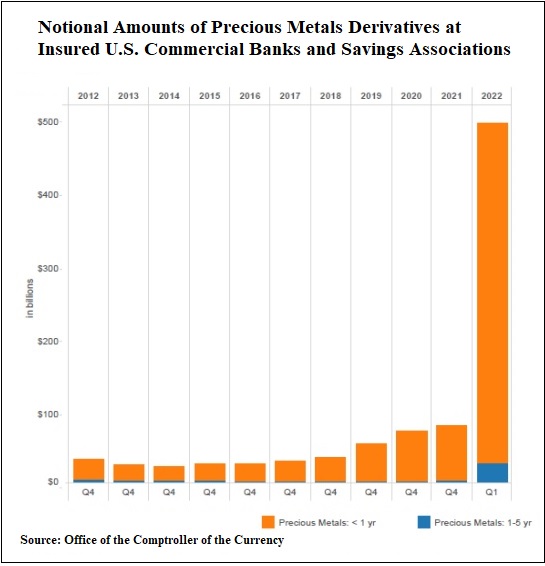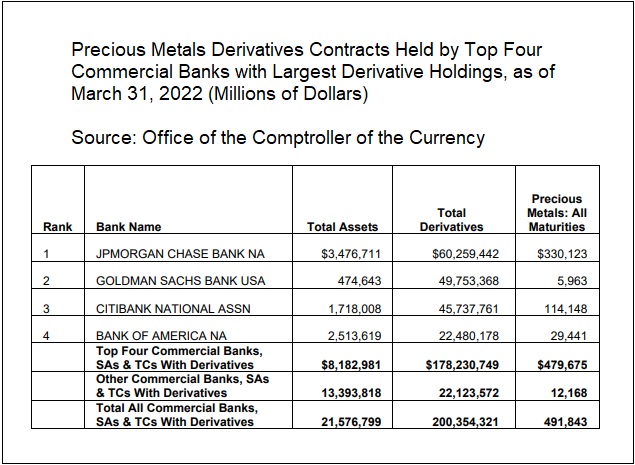By Pam Martens and Russ Martens: June 29, 2022 ~
Last Tuesday, the Office of the Comptroller of the Currency (OCC) released its quarterly report on derivatives held at the megabanks on Wall Street. As we browsed through the standard graphs that are included in the quarterly report, one graph jumped out at us. It showed a measured growth in precious metals derivatives at insured U.S. commercial banks and savings associations over the past two decades and then an explosion in growth between the last quarter of 2021 and the end of the first quarter of this year.
In just one quarter, precious metals derivatives had soared from $79.28 billion to $491.87 billion. That’s a 520 percent increase in a span of three months. (See Figure 18 at this link. The last ten years of the graph is shown above.)
Having studied these quarterly reports since the 2008 financial crash, we knew where to head next. We went to the graphs in the OCC report showing the breakdown of different categories of derivatives at specific banks. Table 21 showed that precious metals contracts at JPMorgan Chase had spiked to $330.123 billion as of March 31, 2022. The same table showed that Citigroup’s insured commercial bank, Citibank, held $114.148 billion in precious metals derivatives.
According to the Federal Deposit Insurance Corporation, as of March 31, 2022, there were 4,796 federally insured banks and savings associations in the U.S. Combine that figure with the latest report from the OCC and it means that just two banks, JPMorgan Chase and Citibank, control 90 percent of the precious metals derivatives of all 4,796 insured financial institutions in the U.S.
We checked the previous OCC report for the quarter ending December 31, 2021. It showed that at year-end 2021, JPMorgan Chase had reported only $28.182 billion in precious metals derivatives versus $330.123 billion three months later – a staggering increase of 1,071 percent.
There was a footnote that attempted to explain the bizarre picture of what was going on in the gold market. It read as follows:
“Beginning January 1, 2022, the largest banks are required to calculate their derivative exposure amount for regulatory capital purposes using the Standardized Approach for Counterparty Credit Risk (SA-CCR). Under SA-CCR gold derivatives are considered precious metals derivative contracts rather than an exchange rate derivative contract resulting in an increase in reported precious metals derivative contracts compared to prior quarters….”
The footnote raised more questions than it answered. According to legal definitions available at Cornell Law School (not to mention common sense), an “exchange rate derivative contract” is “a cross-currency interest rate swap, forward foreign-exchange contract, currency option purchased, or any other instrument linked to exchange rates that gives rise to similar counterparty credit risks.”
Why would a gold derivatives contract have ever been classified as an exchange rate contract? Gold contracts are to foreign exchange contracts what zebras are to a centipede.
There is the decided perception that Wall Street megabanks have been hiding from the public the true extent of their involvement in the gold market through some ginned-up derivative definition.
In addition to the wild growth in precious metals exposure at JPMorgan Chase, Citibank’s precious metals holdings in one quarter had grown from $6.979 billion to $114.148 billion. But Bank of America, a peer bank to JPMorgan Chase and Citibank, showed no such gargantuan increase in its precious metals holdings from year-end 2021 to March 31, 2022. The OCC reports that Bank of America held $27.32 billion in precious metals contracts on December 31, 2021 versus $29.441 billion on March 31, 2022. An increase of just 7.76 percent.
JPMorgan Chase is the last bank in the U.S. that should have a $330 billion involvement in precious metals. On September 29, 2020, the U.S. Department of Justice charged JPMorgan Chase with rigging the precious metals market and charged it with a criminal felony count, to which it admitted. According to the Justice Department, the rigging occurred for more than eight years, from March of 2008 to August of 2016, and involved “tens of thousands” of incidents. The Justice Department wrote that traders at JPMorgan Chase:
“…knowingly and intentionally placed orders to buy and sell precious metals futures contracts with the intent to cancel those orders before execution (‘Deceptive PM [Precious Metals] Orders’), including in an attempt to profit by deceiving other market participants through false and fraudulent pretenses and representations concerning the existence of genuine supply and demand for precious metals futures contracts. By placing Deceptive PM Orders, the Subject PM Traders intended to inject false and misleading information about the genuine supply and demand for precious metals futures contracts into the markets, and to deceive other participants in those markets into believing something untrue, namely that the visible order book accurately reflected market-based forces of supply and demand. This false and misleading information was intended to, and at times did, trick other market participants, including competitor financial institutions and proprietary traders, into reacting to the apparent change and imbalance in supply and demand by buying and selling precious metals futures contracts at quantities, prices, and times that they otherwise likely would not have traded.”
The trading conduct in precious metals was so bad at JPMorgan Chase that the Justice Department took the unprecedented step of charging some of the precious metals traders involved under the Racketeer Influenced and Corrupt Organizations Act (RICO), a statute typically reserved for organized crime figures. In this case, it was used to charge employees of the largest federally insured bank in the United States.
Despite this criminal conduct, federal regulators apparently have no problem with JPMorgan Chase continuing to hold an outsized share of a market it rigged.
The ongoing hearings of the January 6 House Select Committee are peeling back the layers of corruption in the highest office in the U.S. during the Trump administration. It’s time for another House Select Committee to conduct an equally broad investigation of Wall Street’s megabanks, before they crash the U.S. economy in a replay of 2008. Clearly, Wall Street’s federal regulators have failed in their jobs just as miserably as the White House Counsel and White House Chief of Staff failed in their jobs in the Trump administration.
Related Articles:
JPMorgan Chase’s Derivatives Spike by $14 Trillion in First Quarter to Six-Year High of $60 Trillion
A Second Female Lawyer Who Worked at JPMorgan Chase Says Fraud Is Condoned at the Bank
The SEC Is Allowing 5-Count Felon JPMorgan Chase to Trade Its Own Bank Stock in its Own Dark Pools




